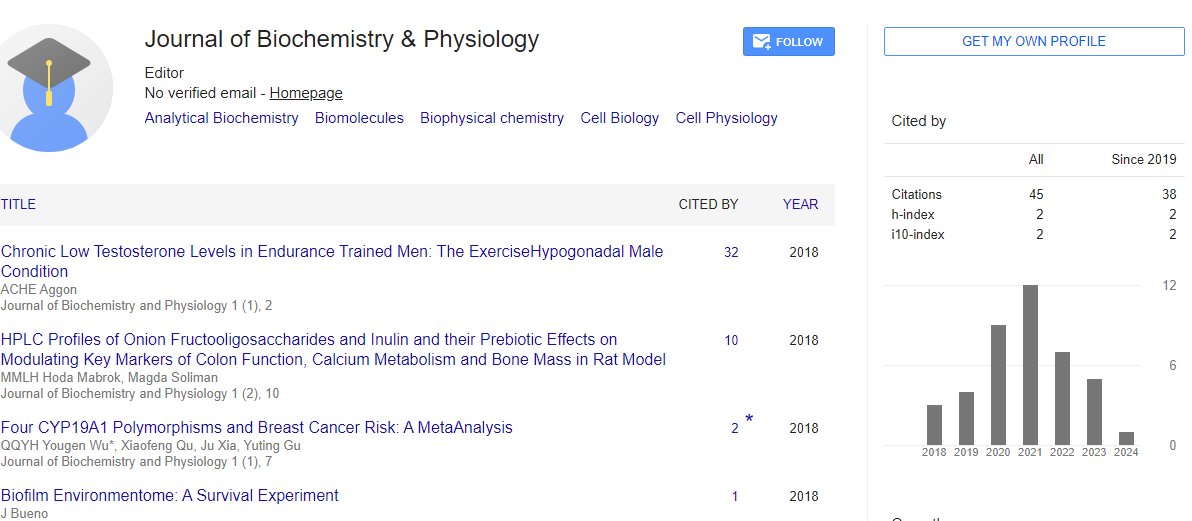Commentary, J Biochem Physiol Vol: 7 Issue: 2
Lipid Biochemistry in Cellular Membranes: Composition and Role
Kharrhof weil*
1Department of Animal Biosciences, University of Guelph, Guelph, Canada
*Corresponding Author: Kharrhof weil,
Department of Animal Biosciences, University
of Guelph, Guelph, Canada
E-mail: Chensa@kas.cy
Received date: 28 May, 2024, Manuscript No. JBPY-24-139477;
Editor assigned date: 30 May, 2024, PreQC No. JBPY-24-139477 (PQ);
Reviewed date: 13 June, 2024, QC No. JBPY-24-139477;
Revised date: 21 June, 2024, Manuscript No. JBPY-24-139477 (R);
Published date: 28 June, 2024, DOI: 10.4172/jbpy.1000159.
Citation: Weil K (2024) Lipid Biochemistry in Cellular Membranes: Composition and Role. J Biochem Physiol 7:2.
Description
Cellular membranes are vital to the structure and function of all living cells, serving as barriers and platforms for various biochemical processes. Lipids, the fundamental components of these membranes, are complex molecules that play critical roles in maintaining membrane integrity, fluidity, and functionality. Membrane lipids are predominantly phospholipids, cholesterol, and glycolipids, each contributing uniquely to membrane structure and function. Phospholipids primary structural components of cellular membranes, forming a bilayer with hydrophobic tails facing inward and hydrophilic heads facing outward.
The most common phospholipids include Phosphatidylcholine (PC), Phosphatidylethanolamine (PE), Phosphatidylserine (PS), and Phosphatidylinositol (PI). The diversity in phospholipid head groups and fatty acid chains allows for membrane fluidity and flexibility, which are essential for cellular processes such as vesicle formation and fusion. Cholesterol is interspersed among phospholipids in the membrane and plays a key role in modulating membrane fluidity and permeability. It maintains membrane stability by preventing the fatty acid chains of phospholipids from packing too closely together, thereby ensuring the membrane remains fluid over a range of temperatures. Glycolipids contain carbohydrate groups attached to a lipid moiety and are typically found on the extracellular side of the plasma membrane. They are involved in cell-cell recognition, signal transduction, and maintaining membrane stability.
Role of lipids in membrane structure and function
Lipids provide the membrane with a dynamic structure, allowing it to change shape and accommodate various cellular processes. The fluid mosaic model of membrane structure suggests that lipids and proteins move laterally within the bilayer, a property essential for functions such as membrane fusion, endocytosis, and the proper functioning of membrane proteins. The fatty acid composition of phospholipids significantly affects membrane fluidity; unsaturated fatty acids create kinks in the hydrophobic tails, preventing tight packing and increasing fluidity. Conversely, saturated fatty acids result in a more rigid membrane. Lipids are not uniformly distributed in the membrane but rather organize into microdomains or lipid rafts. These rafts are enriched in cholesterol, sphingolipids, and certain proteins, and serve as platforms for signaling and trafficking processes. Lipid rafts facilitate the clustering of receptors and signaling molecules, thereby enhancing the efficiency of signal transduction and membrane trafficking.
The hydrophobic core of the lipid bilayer acts as a barrier to the free passage of water-soluble substances. This selective permeability allows cells to maintain distinct internal environments, regulate ion gradients, and control the entry and exit of nutrients, ions, and waste products. Transport proteins embedded in the lipid bilayer facilitate the selective movement of molecules across the membrane. Membrane lipids play a pivotal role in cell signaling. Phosphoinositides, a class of phospholipids, are involved in signaling pathways that regulate cell growth, survival, and metabolism. Upon activation by external signals, these lipids can be phosphorylated or hydrolyzed to produce secondary messengers, such as Inositol Triphosphate (IP3) and Diacylglycerol (DAG), which propagate intracellular signals leading to various cellular responses.
Lipids contribute to the curvature and dynamics of cellular membranes, influencing processes such as vesicle formation, fission, and fusion. Specific lipids like lysophospholipids and phosphatidic acid have cone-shaped structures that induce curvature in the membrane, facilitating the budding of vesicles during endocytosis and exocytosis. Lipids interact closely with membrane proteins, influencing their structure, localization, and function. The lipid environment affects the activity of membrane proteins, including receptors, ion channels, and enzymes, by modulating their conformation and dynamics. Lipid-protein interactions are critical for the proper functioning of membrane-bound receptors and transporters, as well as for the assembly of protein complexes in signaling pathways.
Conclusion
Lipids are integral to the structure and function of cellular membranes, providing the necessary fluidity, permeability, and dynamic properties required for various cellular processes. Their diverse composition allows for the formation of specialized microdomains, contributing to signal transduction, membrane trafficking, and cellular communication. Understanding lipid biochemistry in cellular membranes offers insights into fundamental biological processes and has implications for various fields, including cell biology, pharmacology, and medicine. As research continues, the intricate roles of lipids in cellular membranes will further elucidate the complexities of cellular function and disease mechanisms.
 Spanish
Spanish  Chinese
Chinese  Russian
Russian  German
German  French
French  Japanese
Japanese  Portuguese
Portuguese  Hindi
Hindi 